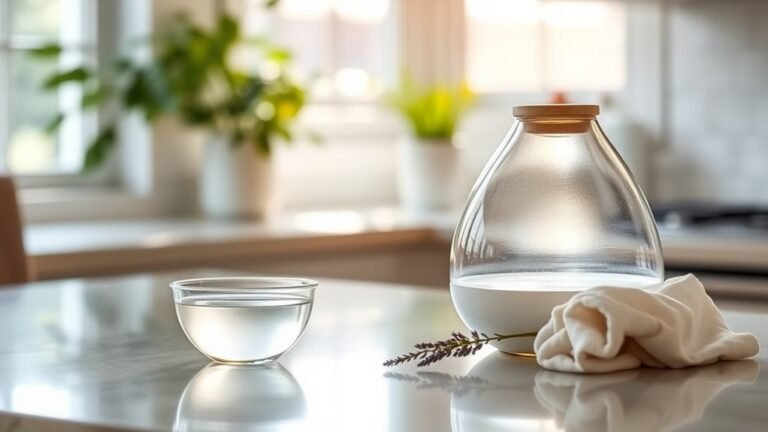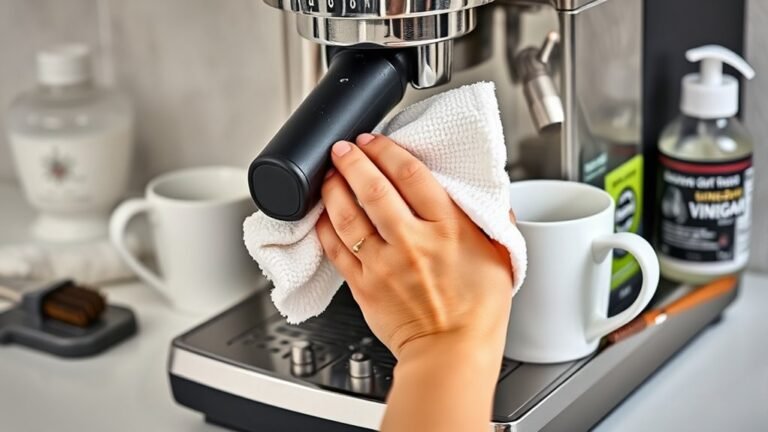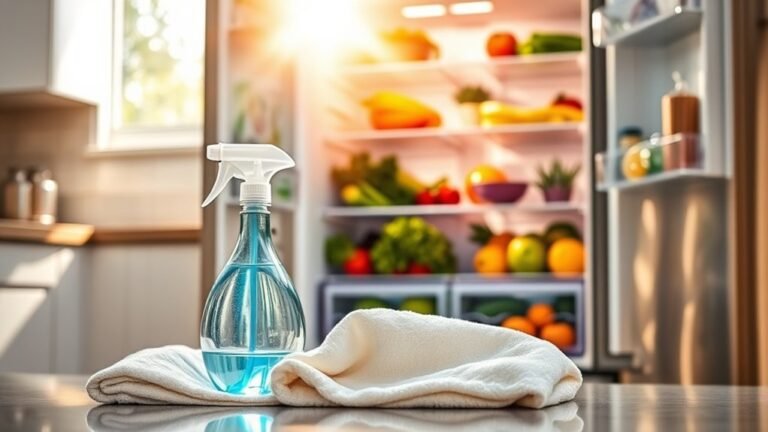Deep Cleaning Checklist for Kitchen
Start your kitchen deep cleaning by clearing and organizing all surfaces, then wipe down and sanitize countertops with food-safe cleaners. Thoroughly clean your sink, faucet, stove, and oven, removing grime and grease. Don’t forget to defrost and clean your refrigerator, wipe cabinets, and disinfect appliances. Finish by sweeping and mopping floors, and emptying plus sanitizing trash and recycling bins to prevent odors and germs. Keep going to uncover handy tips and detailed steps for an immaculate kitchen.
Clear and Organize Kitchen Surfaces

Before you begin deep cleaning, clear and organize all kitchen surfaces to create a clutter-free workspace. This step is vital for an efficient and stress-free cleaning process. Start by removing everything from countertops, tables, and shelves. Use kitchen organization tips like grouping similar items and designating specific zones for cooking, prepping, and storage. Surface decluttering strategies such as sorting items into keep, relocate, or discard piles help you decide what truly belongs in your kitchen. Keep only essentials on your counters to maximize space and freedom to move. A tidy, well-organized kitchen not only simplifies cleaning but also boosts your daily cooking experience, giving you more time to enjoy what matters most.
Clean and Sanitize Countertops
Wipe down your countertops thoroughly to remove crumbs, spills, and grease that can attract bacteria. Different countertop materials require specific care to keep them looking fresh and germ-free. Choose cleaning products that suit your surface—whether it’s granite, laminate, or butcher block—to avoid damage. After wiping, sanitize to eliminate lingering germs and keep your kitchen safe.
Here’s how to do it right:
- Select gentle, surface-appropriate cleaning products to protect your countertops.
- Use a microfiber cloth for effective, streak-free cleaning.
- Apply a food-safe sanitizer to guarantee cleanliness without harsh chemicals.
Deep Clean the Sink and Faucet

Start by removing any food debris stuck in the sink and around the faucet. Next, disinfect the area using a bleach solution to kill germs and bacteria. Finish by polishing the fixtures to restore their shine and keep your kitchen looking fresh.
Remove Food Debris
Clear out any lingering food debris from your sink and faucet to prevent buildup and unpleasant odors. Taking this simple step frees you from the hassles of clogged drains and keeps your kitchen feeling fresh and open. Proper food storage and waste management play a key role here—don’t let scraps pile up and create problems.
To effectively remove debris:
- Scrape leftover food into your compost or trash immediately after meals
- Use a brush or sponge to clean faucet crevices and drain openings
- Flush the drain with hot water to wash away loosened particles
Disinfect With Bleach
Once you’ve removed all food debris, the next step is to disinfect your sink and faucet to eliminate germs and bacteria. Grab some bleach and remember bleach safety: always work in a well-ventilated area and wear gloves to protect your skin. Mix your bleach solution carefully using the recommended dilution ratio—typically 1 tablespoon of bleach per gallon of water—to guarantee it’s effective yet safe. Apply the solution to your sink and faucet, letting it sit for about 5 minutes to kill harmful microbes. Afterward, rinse thoroughly with clean water to remove any bleach residue. This simple step gives you peace of mind, keeping your kitchen environment fresh and free, so you can enjoy the freedom of a truly clean space.
Polish Fixtures Shine
Although your sink and faucet are disinfected, they might still look dull or spotty. Polishing your fixtures not only boosts their shine but also extends their life through proper fixture maintenance. You don’t have to be stuck with water spots or grime that hides their true sparkle.
Try these polishing techniques to set your kitchen free from dullness:
- Use a soft cloth and a gentle, non-abrasive cleaner to buff away spots without scratching.
- Apply a mixture of vinegar and water to cut through mineral buildup.
- Finish with a microfiber cloth to bring out a brilliant shine.
With just a little effort, your sink and faucet will glisten, making your kitchen feel fresher and more inviting.
Thoroughly Clean the Stove and Oven

Cleaning your stove and oven thoroughly is essential to maintain a safe and efficient kitchen. You’ll want to start by removing the grates and burner caps, soaking them in warm, soapy water. Use effective oven cleaning techniques, like applying a paste of baking soda and water, letting it sit overnight, then wiping it clean to tackle stubborn grease. Don’t forget stove maintenance tips such as regularly checking and cleaning burner ports to guarantee even flames. For the oven interior, avoid harsh chemicals by using natural solutions that free you from toxic fumes. By dedicating time to this deep clean, you’re not just improving performance—you’re creating a kitchen that supports your freedom to cook with confidence and ease every day.
Defrost and Clean the Refrigerator
A well-maintained refrigerator keeps your food fresh and your kitchen hygienic. To defrost and clean your fridge effectively, start by unplugging it and removing all items. This pause gives you the freedom to reorganize with food safety in mind. Next, let the ice melt naturally or place towels to catch drips.
Focus on these key steps:
- Remove and wash shelves and drawers with warm, soapy water.
- Wipe down the interior walls and door seals thoroughly.
- Dry everything completely before replacing items to prevent mold and odors.
Wipe Down Cabinets and Drawers
Two simple steps can make your cabinets and drawers look fresh and prevent grime buildup. First, grab a mild cleaner and a soft cloth to wipe down every surface, paying close attention to handles and edges where dirt loves to hide. This quick action not only brightens your kitchen but also stops grime from becoming stubborn. Next, take a moment for cabinet organization—rearrange items so everything has a place, making your kitchen feel more open and freeing your mind from clutter stress. Don’t forget drawer maintenance: remove everything, wipe the interiors, and check for any repairs or sticky spots. By keeping up with these tasks, you’ll enjoy a kitchen that feels liberating and effortlessly clean, ready for whatever you want to create.
Clean and Disinfect Kitchen Appliances
Keeping your kitchen appliances spotless and sanitized is essential for both hygiene and their longevity. When you clean and disinfect appliances regularly, you not only prevent germs but also guarantee they work efficiently longer. Use these appliance maintenance tips and efficient cleaning methods to keep your kitchen hassle-free:
- Unplug appliances before cleaning to stay safe and protect their electronics.
- Use a mixture of mild detergent and warm water for surface cleaning, avoiding harsh chemicals that can damage finishes.
- Wipe down handles, buttons, and touchscreens with disinfectant wipes to kill bacteria without harming sensitive parts.
Sweep and Mop Kitchen Floors
Once you’ve finished cleaning your appliances, it’s time to tackle the kitchen floors. Start by sweeping thoroughly to remove crumbs, dust, and debris that can dull your floor’s finish. Use a broom or vacuum designed for hard surfaces to reach every corner. For effective floor cleaning, choose a mop compatible with your floor type, whether it’s tile, hardwood, or laminate. When mopping, apply your chosen cleaner sparingly to avoid residue buildup. Consider the mopping techniques you use: mop in a figure-eight pattern or straight lines, rinsing your mop frequently to prevent spreading dirt. This approach helps you maintain freedom from sticky spots and grime, leaving your kitchen floors fresh and inviting. Master these steps, and your kitchen will feel open and clean—a space ready for anything.
Empty and Sanitize Trash and Recycling Bins
Before you start scrubbing, make sure to completely empty your trash and recycling bins to prevent odors and bacteria buildup. Taking this step is essential for effective trash disposal and maintaining a fresh kitchen environment. Once emptied, give your bins a thorough rinse and sanitize them using a mixture of water and vinegar or a mild bleach solution. This kills germs and keeps pests away.
Empty and sanitize bins thoroughly to prevent odors, bacteria, and pests for a fresher kitchen environment.
Keep these recycling tips in mind:
- Separate recyclables from trash before cleaning to avoid cross-contamination.
- Use liners to make emptying easier and reduce mess.
- Air-dry bins completely to prevent mold and mildew growth.
Frequently Asked Questions
How Often Should I Deep Clean My Kitchen?
You should deep clean your kitchen about once every season to keep it fresh and fully sanitized without feeling overwhelmed. Alongside that, stick to a weekly schedule for lighter cleaning tasks like wiping surfaces and sweeping floors. This balance gives you freedom from constant scrubbing while maintaining a healthy, inviting space. Seasonal cleaning lets you tackle bigger jobs, so you enjoy a kitchen that’s both spotless and stress-free year-round.
What Natural Cleaners Are Best for Kitchen Deep Cleaning?
When you want to deep clean your kitchen naturally, vinegar and baking soda are your best friends. Vinegar benefits include cutting through grease and killing bacteria, making surfaces sparkle without harsh chemicals. Baking soda’s gentle abrasiveness helps scrub away grime and deodorizes your space. Together, they give you a powerful, free-spirited way to keep your kitchen fresh and clean, so you can enjoy a toxin-free environment while embracing your love for natural living.
How to Safely Clean Kitchen Grout and Tiles?
When tackling grout cleaning, you’ll want to mix baking soda with water into a paste and apply it to grout lines. Let it sit, then scrub gently with a toothbrush to avoid damage. For tile maintenance, regularly wipe down surfaces with a vinegar-water solution to keep tiles shining without harsh chemicals. This way, you keep your kitchen fresh and safe while enjoying the freedom from toxic cleaners.
Can I Use Bleach on Kitchen Surfaces?
You might think bleach is the ultimate cleaner, but its harshness can clash with your desire for surface safety. While bleach can disinfect, it risks damaging some kitchen surfaces and releasing strong fumes. Instead, consider bleach alternatives like vinegar, baking soda, or hydrogen peroxide—they’re gentler yet effective. These options let you keep your kitchen fresh without compromising your freedom to choose safer, eco-friendly solutions that protect both your space and health.
How to Maintain a Clean Kitchen Between Deep Cleans?
To keep your kitchen fresh between deep cleans, stick to daily habits like wiping down counters after cooking and rinsing dishes promptly. Quick tips include sweeping the floor each evening and taking out the trash regularly. You’ll enjoy more freedom knowing your space stays tidy without extra effort. Keep a spray bottle of natural cleaner handy for quick touch-ups, so your kitchen stays inviting and ready whenever you need it.






